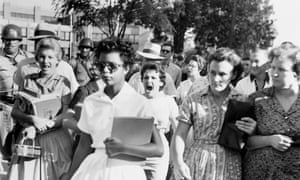
Rachel Gladstein
AP government and politics
Ms. Gordon
The Supreme Court is the highest federal court that makes the final decisions regarding cases. It consists of 8 associate justices and one chief justice. The Supreme Court’s role is to decide on cases dealing with the interpretation of the constitution. There have been a number of Supreme Court cases in history that have dealt with controversial issues that have changed laws and rules in the United States. Three major court cases in our history are Brown vs. Boe, Roe vs. Wade, and Citizens United vs. FEC.
Supreme Court case named Brown vs. Boe (347 US 483 (1954)) occurred in 1954 when justices ruled that segregation in public schools is unconstitutional. The case began in 1951 after Linda Brown was denied entrance to the all white elementary schools in Topeka, Kansas. Linda’s father, Oliver Brown filed a class action suit against the Board of Education of Topeka. He claimed that schools for black children are unequal to schools for white children. The case originated in the U.S District Court in Kansas where they agreed that public school segregation has negative effects on colored students. Brown and four other school segregation cases combined into one named Brown vs. Boe in the Supreme Court. The chief of justice read the unanimous verdict against school segregation. The liberal court ruled that the laws regarding school segregation is unconstitutional. This case relates the 14th amendment. The segregation laws denying Linda’s entrance into school gives her an unequal opportunity because of her race and violates the equal protection clause protected by the 14th amendment. This ruling and case lead to an outbreak of the civil rights movement all over the United States.
Roe vs. Wade (410 US 113 (1973)) was another case which occurred in 1973. In 1969, Norma Mccorvey known as “Jane Roe” was a Texas women in her early 20’s who wanted an abortion for an unwanted pregnancy. However, In Texas, abortion was legal only in circumstances where it was needed to save a woman's life. Until the late 1900’s, abortion was illegal and 200,000 women were receiving dangerous abortions illegally. In 1970, the case originated in the Texas District court which ruled that the states abortion ban was illegal because it violated a constitution right to privacy. However, Henry Wade, the district attorney of Dallas continued to prosecute doctors who gave the abortion procedure. The case moved up to the Supreme Court and chief justice Harry wrote the majority decision. A 7-2 decision by a conservative court ended the Texas law banning abortion and further legalized abortion nationwide. This case relates the the 14th amendment because Roe had the right of privacy to decide to have an abortion which is protected by the 14 amendment. The Roe vs. Wade decision lead to the increase of support of the women's rights movement across the country.
Finally, the case named Citizens United vs. FEC (Federal Election Commission) (558 US _(2010)) occurred on January 21, 2010. The case arose in 2008 when Citizens United released the documentary, Hillary: The Movie which was highly critical of candidate, Hillary Clinton. In 2002, Congress passed the BCRA Act which prevented corporations from using their general treasuries to fund ratio or TV that refers to candidates within 60 days of an election. The case originated in the US district in Washington D.C when FEC wanted penalties on citizens for the Hillary movie. The district court ruled against Citizens United and moved to the Supreme Court. The conservative court ruled in a 5-4 decision that laws preventing corporations and unions funding political candidates violated freedom of speech from the first amendment. The Chief justice voted with Citizens United. This case relates to the first amendment because the corporations have freedom of speech. The Supreme Court decision lead to hundreds of millions of dollars funded towards political candidates which influenced local, state, and federal elections.
These three cases have made large impacts on America. These cases can still be learned about and connected to other issues occurring in 2019. The Brown vs. Boe case relates to other minorities receiving discrimination and unequal rights. Some minorities don't receive equal opportunities for jobs and education. The Roe vs. Wade case relates to the abortion ban laws in states such as Alabama. Women in Alabama do not have the right to privacy and can not decide whether or not they want an abortion. The Citizens United vs. FEC relates to issues today about hate speeches and the debate about whether they are freedom of speech or not. These cases not only change laws, but change viewpoints and perspectives for many people. Cases such as Brown vs. Boe, Roe vs. Wade, and Citizens United can be used in many other cases and can help us learn and develop new viewpoints.
Works cited:
410 US 113 (1973)
347 US 483 (1954)
558 US _ (2010)


Comments
Post a Comment